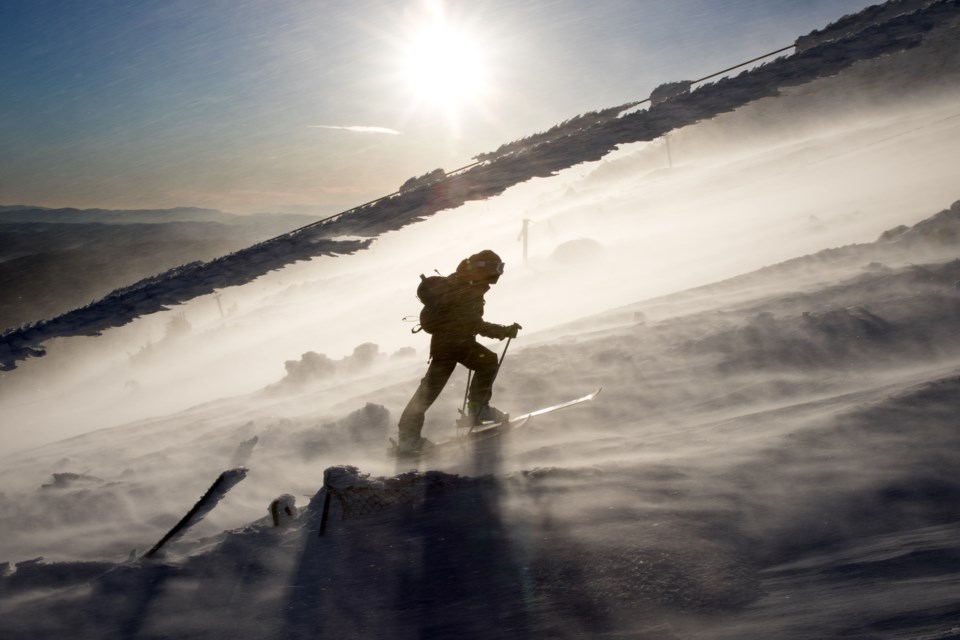Well, we finally got that season turnaround we were looking for. One minute we’re dodging rocks in the rain, the next we’re lining up at 5 a.m. to ski the biggest storm in what felt like years. Welcome back, winter. We missed ya.
When weather doesn’t go our way (like in December), there are a few things we can do.
1. Make the most of it by appreciating where we live and the proximity to these mountains.
2. Complain about it online by positing that we all deserve season-pass refunds or credits for the following season.
3. Watch the weather and get ready to pounce on the next cold, precipitation-heavy system that hits the south coast.
Being already a staunch supporter of Option 1 and often making fun of the folks who love Option 2, I’m going to elaborate a bit on Option 3. Everyone has their preferred method of monitoring the weather—this is just a sample of the resources I use. A caveat about weather forecasts before we get into it: anything more than three to four days out is hard to predict for any weather model, so treat anything beyond that as definitely-maybe.
Big-picture baseline: The Weather Network
Before looking at any quantified snow forecasts, I like to get a feel for what’s going on in the valley and the region. The Weather Network is my forecast app of choice year-round. It has an excellent user interface where you can easily switch between saved locations and check short-term (72-hour) forecasts down to the hour, mid-term (seven-day) forecasts with decent accuracy, and a long-range (14-day) outlook for an idea of what’s on the way. The app has ads, but they don’t really get in your way.
Conservative outlook: The Whistler Blackcomb Forecast (RWDI)
Back around 2010, college researchers uncovered historical data showing some ski resorts in the U.S. were over-reporting snowfall amounts on Saturday and Sunday mornings by as much as 23 per cent in an effort to increase regional visitation. The deceptive tactic largely became obsolete after social networks and rapid data-sharing (i.e. people posting from their phones) allowed the public to debunk any false information.
So skiers were wary of weather information released by resorts. To remain as transparent as possible and maintain consumer confidence, Whistler Blackcomb (WB) contracts its weather forecasting to consulting firm RWDI, which you can find on the WB website or the Epic app. The seven-day forecast includes the outlook, temperature highs and lows, wind speed, expected snow accumulation and, most importantly, freezing level.
In recent years I’ve found the RWDI forecast to be quite conservative with the amount of snowfall we can expect. When you’re dealing with skiers with high expectations, it’s often best to under promise and over deliver.
Optimistic outlook: snow-forecast.com
Infamous for its overestimation of expected snowfall, snow-forecast.com is likely the most screenshotted-and-shared weather app on the internet. On the plus side, it does give you a general idea of the storm intensity at peak, mid-mountain, and valley elevations (in the short term), and the freezing-level numbers are generally pretty close.
The app is free (with some annoying ads) for the six-day forecast, with monetized “premium” access to its 12-day forecast. If you’re thinking about upgrading to the 12-day version, don’t bother. With snow-forecast.com’s reputation for fuelling snowsport clickbait articles, you’re better off sending some money to the guy working locally to bring us the best weather information (see below).
Best for backcountry: Avalanche Canada
Any ski-tourers reading this already realize the importance of checking the daily bulletin from Avalanche Canada, but the app and website both have excellent weather forecasting that can be cross-referenced for backcountry route planning. This should be a mandatory check if you intend to set foot beyond the ski-area boundary.
Deep dive for advanced users: SpotWx
I won’t go into the features and capabilities of this particular resource, but as the title suggests, it requires an experienced user to interpret and compare the various numerical models and weather-station data streams aggregated by SpotWx. Recommended for weather obsessives, ski/mountain guides, or anyone else looking for a meteorological hobby.
The best of everything: whistlerpeak.com and Peak Live App
Created by Whistler local Brad Meraly, Whistler Peak is by far the most useful resource for skiing at Whistler Blackcomb. It consolidates all the aforementioned weather resources in a single app with more than enough granular data (such as graphs, weather plots, and live telemetry all over Whistler and Blackcomb) to keep the weather nerds busy.
It has loads of other helpful resort information (such as updates from the comms team) so you can get an idea of why lifts suddenly close or which WB parking lots are already full.
Meraly maintains the app and has kept it ad-free, so make sure you click on the “support this project” link and buy him a few coffees for his trouble.
Honourable mention: onthesnow.com
I don’t travel as much for skiing these days, so I haven’t used this app much. But if you were looking for the best resort to book your ski trip and wanted to get a sense of current conditions (including recent reports from other skiers), onthesnow.com is a popular resource for mainstream snowsport enthusiasts.
Vince Shuley is feeling like it’s winter again. For questions, comments or suggestions for The Outsider, email [email protected] or Instagram @whis_vince.




